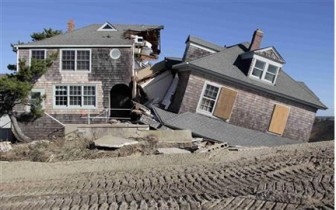NEW YORK, (Reuters) – A housing crisis loomed in New York City as victims of superstorm Sandy struggled without heat in near-freezing temperatures yesterday and nearly 1 million people in neighboring New Jersey remained without power.
Fuel shortages and power outages lingered nearly a week after one of the worst storms in U.S. history flooded homes in coastal neighborhoods, leaving many without heat and in need of shelter. Mayor Michael Bloomberg said 30,000 to 40,000 people in New York City alone would need shelter.
“We don’t have a lot of empty housing in this city. It’s a problem to find housing. We’re not going to let anybody go sleeping in the street,” Bloomberg said. “But it’s a challenge and we’re working on this as fast as we can.”

Temperatures dipped to 39 Fahrenheit (4 degrees Celsius) on Sunday morning in New York City, the lowest in days. Freezing temperatures were expected overnight. An early-season “Nor’easter” storm was expected to hit the battered New England coast this week with strong winds and heavy rain.
“The power is back, but we have no heat,” said Adeline Camacho, a volunteer who was giving soup and sandwiches to needy residents of the Lower East Side of Manhattan yesterday. “A lot of people haven’t been able to bathe or stay warm. Last night was cold and this night is going to be much worse.”
U.S. Homeland Security Secretary Janet Napolitano said federal agencies are looking for apartments and hotel rooms for people displaced by Sandy. “Housing is really the number one concern,” Napolitano said at a news conference with New Jersey Governor Chris Christie.
Overnight, at least two more bodies were found in New Jersey – one dead of hypothermia – as the overall North American death toll from Sandy climbed to at least 113.
“People are in homes that are uninhabitable,” New York Governor Andrew Cuomo said at a news conference.
Concerns are also growing that voters displaced by Sandy won’t get to polling stations on Election Day on Tuesday. Scores of voting centers were rendered useless by the record surge of seawater in New York and New Jersey.
STRUGGLING IN STATEN ISLAND
Sandy killed 69 people in the Caribbean before turning north and hammering the U.S. Eastern Seaboard on Monday with 80 mile-per-hour (130-kph) winds.
The two new deaths in New Jersey – where the storm came ashore last Monday night – included a 71-year-old man who suffered from hypothermia and a 55-year-old man who died from smoke inhalation in a house fire, police said on Sunday.
That raised New Jersey’s death toll to 24 while the New York City death count was 40.
In the hard-hit borough of Staten Island, Marie Mandia’s house had a yellow sticker on it, meaning the city restricted its use. The storm surge broke through her windows and flooded her basement and main floor, the retired teacher said.
“I’m not staying here. There’s no protection,” said Mandia, 60, who stood outside by a pile of her ruined things – a washer, drier, television and furniture. “Here’s my life. Everybody’s looking at it.”
Similar scenes of destruction were to be seen in the Rockaways, a strip of land along the Atlantic in Queens. Street after street, people were digging out from under feet of sand and cleaning up from the deluge of water that ripped apart fences, turned over cars and left homes flooded.
Volunteers made their way there to help, even as life appeared to be back to normal in Times Square, where the neon lights were bright and Broadway theaters were up and running.
“It’s like the city, the officials, have forgotten us. Only our neighbors and strangers, volunteers, have been here,” Gregory Piechocki said. “We don’t need food or water. We need a warm place to sleep and some sign that we aren’t forgotten.”









